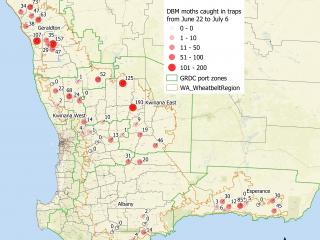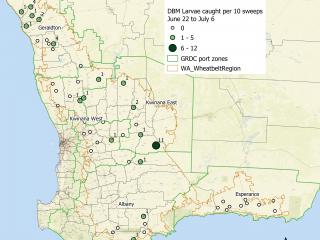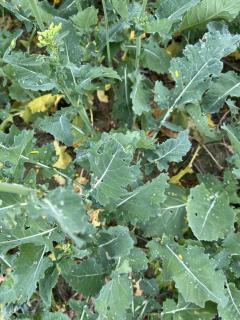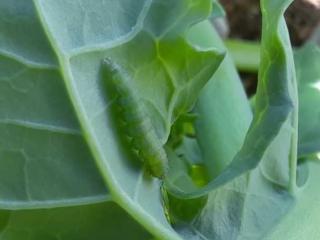Diamondback moth
- Narembeen
- Mukinbudin
- Hopetoun
- Munglinup
- Grass Patch
- Scaddan
Growers and agronomists are encouraged to inspect canola crops for diamondback moth (DBM) caterpillars in the Esperance and eastern grainbelt areas, especially earliest sown crops, as moth numbers have increased, and larvae numbers are appearing.
India Warren-Hicks (South East Rural Traders) has swept for DBM caterpillars in an early flowering canola crop at Grass Patch. There were 45-50 DBM caterpillars on average in 10 sweeps in sections of the paddock which had been waterlogged and/or plants were moisture stressed. All instar stages and DBM moths were found in the sweeps. Whereas in a later sown canola crop only 10 km away, which was at the cabbage stage, low levels of DBM caterpillars were found. Interestingly the ten canola focus crops in the Esperance shire being monitored by South East Agronomy Research (SEAR) (mentioned below) had no larvae detected in sweeps.
Agronomists have also reported to PestFacts WA that canola crops at Hopetoun, Scaddan and Munglinup have low numbers of DBM caterpillars causing some shot hole damage. Crops will be monitored.
Research scientist Christiaan Valentine (DPIRD) has found an average of 11 DBM per 10 sweeps in bolting/early flowering canola crop near Narembeen, which was up from five per 10 sweeps the previous fortnight. Christiaan also found two per 10 sweeps in a canola crop at Mukinbudin a week ago, but it was difficult to assess on an icy morning. However, a high spike of DBM moths were detected in the pheromone trap and shot-hole damage was easily seen in the leaves so further monitoring is warranted to see if the increase in moths results in an increase in larvae.
As part of a GRDC-funded project on DBM surveillance DPIRD staff along with grower groups (Mingenew Irwin Group, West Midlands Group and Liebe Group) and SEAR are conducting widespread surveillance for DBM moths and larvae in focus crops during the season. 51 focus crops throughout the grainbelt are being monitored fortnightly throughout the season. The surveillance team will provide regular updates to growers and consultants throughout the season through the PestFacts WA e-newsletter.
So far, the surveillance project has captured high numbers of moths in traps for some northern, eastern and Esperance areas but low numbers, or no, DBM larvae (see maps below). In some cases, minor feeding damage to leaves was visible.


The earliest sown canola crops can be more at risk of early DBM increase and canola plants are more vulnerable to caterpillar damage when they are stressed (due to dry or very wet conditions) and closer to flowering.
DBM caterpillar activity should slow down in cold, wet weather conditions and then ramp up in spring but DPIRD's Seasonal Climate Outlook report for July 2022 is predicting above average daytime temperatures for the July to September period which encourages pest activity and reproduction.
Growers and consultants are advised to monitor for DBM, especially from August onwards, by doing at least four lots of ten sweeps with an insect net at various locations in each crop.
Identifying and managing diamondback moth
DBM caterpillars are pale green, cigar-shaped and up to 12mm in length. They wriggle violently when disturbed and can drop down on a fine thread.

Damage from these grubs appears as chewed leaves, buds and flowers with the leaf chewing ranging from irregular holes in leaves to extensive leaf damage.
DBM caterpillars drop from plants when disturbed, and bashing some plants, especially those with holes in leaves, over an ice cream container is a good initial indication of their presence if you don’t have a sweep net handy.
Canola plants can recover from quite a lot of leaf defoliation early in the season.
DBM are difficult to control because they breed prolifically and insecticide sprays have limited coverage in advanced canola canopies.
Thresholds for pre-flowering canola control are:
- pre-flowering (stressed crop) - 30 or more grubs per 10 sweeps
- pre-flowering (no stress) - 50 or more grubs per 10 sweeps.
DBM thresholds for flowering canola are:
- early to mid-flowering (no stress) - 50 caterpillars or more per 10 sweeps
- mid to late flowering (no stress) - 100 or more caterpillars per 10 sweeps.
For more DBM information refer to:
- DPIRD’s Diagnosing diamondback moth page
- GRDC's Diamondback moth fact sheet
- GRDC’s Managing diamondback moth video.
For more information contact
- Research scientist, Svetlana Micic, Albany on +61 (0)8 9892 8591
- Technical officer, Alan Lord, South Perth on +61 (0)8 9368 3758
Article authors: Cindy Webster (DPIRD Narrogin), Svetlana Micic (DPIRD Albany), Dusty Severtson (DPIRD Northam) and Alan Lord (DPIRD South Perth).
Article input: Christiaan Valentine (DPIRD Northam).

